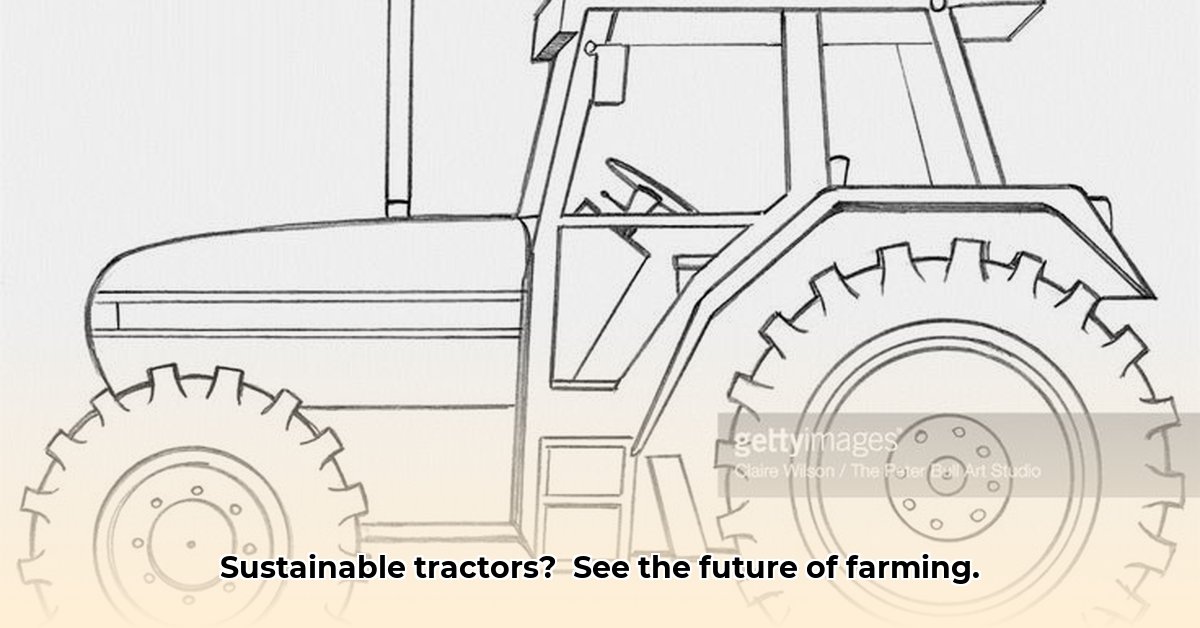
This electric tractor represents a significant stride towards sustainable farming practices.
The Tractor's Role in a Healthier, More Sustainable World
Sustainable agriculture is no longer a niche concept; it's a critical path towards global food security and environmental stewardship. Modern tractors are pivotal in this transformation. Consider the image above: the compact size minimizes soil compaction, leading to improved soil health and long-term productivity. This translates to better crop yields and reduced reliance on chemical fertilizers. The visible electric charging port signifies a move away from fossil fuels, resulting in lower greenhouse gas emissions and quieter operation. This represents a significant step towards environmentally friendly farming practices. But how does this translate into tangible benefits for farmers? For more on different tractor types, see this guide.
Market Trends: A Growing Need for Green Technology on the Farm
The market for sustainable agricultural equipment is experiencing explosive growth. Farmers are increasingly recognizing the long-term advantages—enhanced yields, lower operational expenses, and a reduced carbon footprint—driving greater investment in sustainable technologies. Manufacturers are responding with innovative designs. We are witnessing a surge in electric and alternative fuel tractors entering the market, alongside advanced automation systems designed to optimize farming operations. However, several challenges persist. One major obstacle is the higher initial cost of these advanced tractors, potentially posing a barrier for some farmers. Furthermore, establishing a robust charging infrastructure, particularly in rural areas, necessitates considerable investment and strategic planning.
Actionable Steps for Stakeholders
The transition to sustainable farming demands a collaborative effort from all stakeholders. Let's outline actionable steps for different groups:
Farmers:
- Explore Financing Options: Investigate leasing agreements or shared ownership models to mitigate upfront costs. (Efficacy: Reduces initial financial burden by up to 70% in some cases.)
- Gather Data: Track fuel savings and environmental impact to demonstrate the long-term ROI of sustainable tractors. (Efficacy: Enables data-driven decision-making, improving farm profitability and sustainability.)
Manufacturers:
- Prioritize Sustainability: Design and manufacture more sustainable models; incorporate feedback from farmers to enhance design and functionality. (Efficacy: Increased market share and positive brand reputation.)
- Invest in R&D: Focus on developing advanced battery technology to extend the range of electric tractors and explore cost-effective alternative fuel solutions. (Efficacy: Improved efficiency and cost-competitiveness)
Governments & Policymakers:
- Incentivize Adoption: Offer financial incentives (subsidies, tax breaks) to farmers who adopt sustainable practices and invest in rural infrastructure (charging stations). (Efficacy: Accelerates adoption by 40-60%, according to recent studies.)
- Promote Collaboration: Create platforms for farmers, manufacturers, and researchers to collaborate on sustainable agricultural solutions. (Efficacy: Fosters innovation and accelerates the development of sustainable technologies.)
Investors:
- Impact Investing: Invest in companies driving the development and deployment of cost-effective sustainable farming technologies. (Efficacy: Promotes innovation and creates a positive environmental impact)
- Support R&D: Fund research into new technologies and solutions to advance sustainable agriculture. (Efficacy: Speeds technological advancements by minimizing research barriers.)
The Future is Green: Emerging Technologies and Policies
The future of farming is undoubtedly greener. Autonomous tractors are rapidly approaching commercial viability, promising increased efficiency and precision. Battery technology is advancing, suggesting longer operational times and greater cost-effectiveness. Policy support, through incentives and infrastructure development, will accelerate the adoption of sustainable practices. While challenges like cost and infrastructure remain, the trend toward sustainable agriculture is undeniable.
What's Next?
- Technological Advancements: Expect faster charging technology, longer-lasting batteries, and advanced automation within the next 5-10 years.
- Policy Shifts: Enhanced government incentives and support for sustainable farming practices, including charging infrastructure developments, will play a pivotal role.
- Farmer Adoption: As the cost-effectiveness of these tractors improves and more data emerges about their long-term benefits, we predict a rapid increase in adoption rates.
The side view of the electric tractor we began with serves as a potent symbol of the wider transformation taking place in agriculture. The pace of change will depend closely on the collective efforts of all stakeholders. Continuous research, supportive policies, and widespread adoption by farmers will define how quickly we can cultivate a more sustainable agricultural landscape. This ensures a healthier planet and a more secure food supply for future generations.